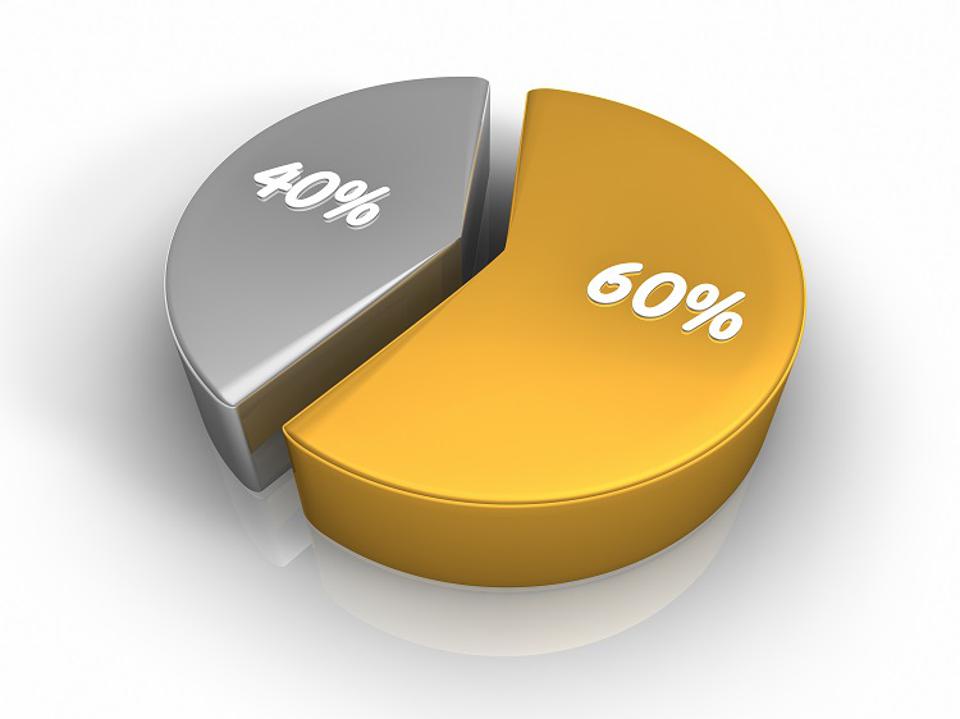The 60/40 Portfolio Is Dead
Here’s how advisors are replacing it.
Thanks for the memories, 60/40. A mix of 60% stocks and 40% bonds, or something close to it, could for decades be expected to produce enough stable growth and steady income to meet retirement goals. But sky-high stock prices, rock-bottom interest rates and an increasing tendency for the two asset classes to move in lockstep has prompted most advisors to ditch the formula. What are they doing instead? That’s the topic of this Big Q, our weekly feature where we ask advisors to weigh in on important questions.
Brenna Saunders, partner and wealth planner, Creative Planning: With longer and longer life expectancies, the typical retiree depends on their portfolio to meet their needs for decades, so we’ve never believed that large bond allocations are appropriate for them.We typically recommend having enough invested in bonds to get through a prolonged bear market and invest what remains in investments with a higher upside than bonds.
For most clients, the assets that would typically be invested in bonds under the 60/40 formula are directed to publicly traded equities instead. While stocks are inherently more risky than bonds in the short run, there is a long-run risk that a client outlives a portfolio that is positioned too conservatively in a low-interest-rate environment. When you add in the impact of inflation, a 60/40 portfolio may actually be less likely to achieve their goals. On paper, the portfolio may appear to be further out on the risk spectrum, but in reality is positioned appropriately when considering all of the risks to a client’s financial independence. For some clients, adding the private equivalent of publicly traded stocks or bonds may be appropriate and improve long-term expected performance. This should be balanced against the client’s needs for liquidity and concerns around complexity.
Jay Winthrop, partner, Douglass Winthrop Advisors: We only view bonds as an alternative to cash, not as an offensive weapon for seeking investment return. Alternatives have, in our view, substantial drawbacks for the average taxable investor. That leaves us with a default position of being overweight equities. That’s always been our approach, but now, with where interest rates are, we are at the very high end of our allocation to equity.
If we are mandated to be 85/15, let’s say, we are at 85% for equities. We have a fairly concentrated portfolio of about 30 companies, and all of them meet five or six core tests: They all have wide economic moats, pristine balance sheets, abundant reinvestment opportunity, they trade at valuations we believe represent discounts to their intrinsic value, and they’re run by managements that are very shareholder oriented. In the current environment, where you have high equity prices but even higher bond prices, we are adding a few other factors. We’re really favouring businesses that have a high degree of pricing power, that have a low degree of capital intensity—meaning they don’t require external financing to fund operations—and that are addressing large global markets.
Andrew Burish, advisor, UBS: Based on UBS’s capital market assumptions, we prefer a 45%-25%-30% allocation: 45% is in U.S. and foreign equities, 25% is in short-duration fixed income, and 30% is in alternative investments. Most of our clients are either accredited investors or qualified purchasers; they either have a net worth of $2 million minimum or $5 million minimum. That gives us a lot more flexibility for the 30% that we use in alternatives.
[By using alternatives], we reduce risk while maintaining projected returns, or we enhance projected returns while maintaining the same risk. That 30% alternatives sleeve could be a blend of private equity, hedge funds and private real estate. For people who need income, we utilize a liquidity strategy. We’ll take out one to three years of income that they’ll need and we keep that in a separate strategy with short-duration fixed-income investments. This allows a client to go out further on the risk spectrum within their 45-15-30 investment strategy if needed to meet their financial planning goals.
The 45% that’s in stocks would probably be split with 30% in U.S. stocks, diversified across small-cap, mid-cap and large-cap, and 15% in foreign—developed markets and emerging markets in a pooled vehicle of some kind. It’s a little bit overweight the U.S., but there’s a big dose of foreign stocks in there.
Matt Gulbransen, president, Pine Grove Financial Group: The first thing we’re doing is resetting expectations. For that client who is used to making 7% or 8% this past decade, and thinks that will continue in retirement, we’re rethinking that. We’re not completely abandoning bonds in that 60/40 model, but we’re definitely taking 20% of that allocation, give or take, and trying to find alternative, non-correlated asset classes that can generate bond-like returns without the interest-rate and credit risk. We’ve done some real estate-type investments like data centres and cellphone towers. Things like that might be a little bit different, but they still provide stable fixed income. A lot of open-ended ETFs or mutual funds will invest in companies that own those types of real estate. There are real estate trusts that are designed specifically to buy data centres that have long-term corporate leases and then kick out [income] just like an industrial property or an office property.
We’re also going more into hedging-type strategies. We’re trying to put a fence around the volatility of your portfolio: If the market’s up 20% or 30% you’re going to hit the top of that fence and you’re not going to make more than that. But if the market goes down 30% or 40%, you’re not going to have that downside volatility. We are outsourcing that to managers. For us it’s well worth the 30 to 50 basis points that you pay for a good ETF or mutual fund that can do a covered call or some sort of options strategy to hedge out of the volatility of the stock market.
Scott Tiras, advisor, Ameriprise: As we build our allocations, we continue to consider the unique challenges of the low-yielding fixed income market. While we strongly believe in keeping a good portion not in stocks for most of our clients, we also recognize the need for this portion to contribute to the portfolio’s returns. We sometimes tell our clients that stocks are for capital appreciation purposes and bonds are more for capital preservation purposes.
One strategy we employ is to add a bit more exposure to non-traditional equities and reduce the fixed-income exposure to about 30%. However, we then need to turn the volume down on the risk in the equity portfolio to offset the additional market risk. We do this by looking at higher quality large-cap dividend stocks and REITs that do not have exposure to shopping centers or office buildings and provide a good yield. We are also keeping a close eye on the availability of shorter-term—less than three-year maturity—equity structured notes that provide a limit or buffer on the downside, but leverage on the upside. For fixed income, we’re including more Treasury Inflation Protected Securities (TIPS) and ETFs or funds with a bit more credit risk than interest rate risk.
Reprinted by permission of Barron’s. Copyright 2021 Dow Jones & Company. Inc. All Rights Reserved Worldwide. Original date of publication: November 4, 2021
 Copyright 2020, Dow Jones & Company, Inc. All Rights Reserved Worldwide. LEARN MORE
Copyright 2020, Dow Jones & Company, Inc. All Rights Reserved Worldwide. LEARN MORE
This stylish family home combines a classic palette and finishes with a flexible floorplan
Just 55 minutes from Sydney, make this your creative getaway located in the majestic Hawkesbury region.
More than one fifth of Australians are cutting back on the number of people they socialise with
Australian social circles are shrinking as more people look for ways to keep a lid on spending, a new survey has found.
New research from Finder found more than one fifth of respondents had dropped a friend or reduced their social circle because they were unable to afford the same levels of social activity. The survey questioned 1,041 people about how increasing concerns about affordability were affecting their social lives. The results showed 6 percent had cut ties with a friend, 16 percent were going out with fewer people and 26 percent were going to fewer events.
Expensive events such as hens’ parties and weddings were among the activities people were looking to avoid, indicating younger people were those most feeling the brunt of cost of living pressures. According to Canstar, the average cost of a wedding in NSW was between $37,108 to $41,245 and marginally lower in Victoria at $36, 358 to $37,430.
But not all age groups are curbing their social circle. While the survey found that 10 percent of Gen Z respondents had cut off a friend, only 2 percent of Baby Boomers had done similar.
Money expert at Finder, Rebecca Pike, said many had no choice but to prioritise necessities like bills over discretionary activities.
“Unfortunately, for some, social activities have become a luxury they can no longer afford,” she said.
This stylish family home combines a classic palette and finishes with a flexible floorplan
Just 55 minutes from Sydney, make this your creative getaway located in the majestic Hawkesbury region.






















